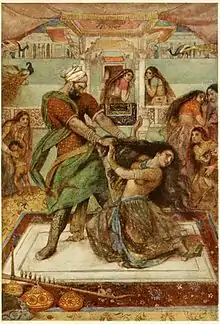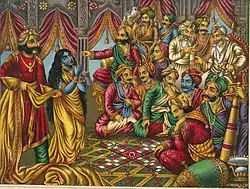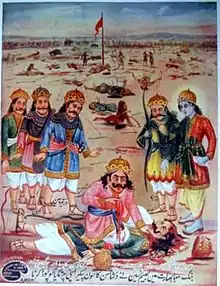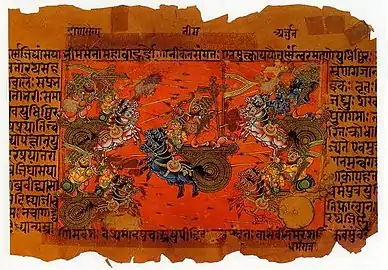Dushasana
Dushasana (Sanskrit: दुःशासन, Duḥśāsana), also spelled as Dussasana and Duhsasana, was a Kaurava prince, the second son of the blind king Dhritarashtra and Gandhari and the younger brother of Duryodhana in the Hindu epic Mahabharata.
| Dushasana | |
|---|---|
| Mahabharata character | |
 Dushasana drags Draupadi from her chamber. | |
| In-universe information | |
| Weapon | Bow and arrows |
| Family | Dhritarashtra (father) Gandhari (mother) Duryodhana, Vikarna, Duhsala and 97 others (siblings) |
| Spouse | unknown |
| Children | Drumasena |
Etymology
The name is often derived from two elements, the Sanskrit: duh, meaning "bad or atrocious" and sasana, meaning "governance or reign". So the word Duhshasana means "A Bad Governance" or "An Atrocious Ruler".
Birth and Early Life
When Dhritarashtra's queen Gandhari's pregnancy continued for an unusually long time, she beat her womb in frustration and in envy of Kunti, the queen of Pandu, who had given birth to three of the five Pandava brothers. Due to her actions, a hardened mass of grey-coloured flesh emerged from her womb. Gandhari was devastated, and called upon Vyasa, the great sage who had blessed her with one hundred sons, to redeem his words.[1]
Dussasana was devoted to his older brother Duryodhana. He was also closely involved in the various schemes and plots to kill the Pandavas along with Duryodhana and Shakuni.
Draupadi's humiliation

After Yudhishthira lost his kingdom, his brothers and his wife Draupadi, in a game of dice with Shakuni, Duhshasana dragged Draupadi by the hair into the assembly, at the behest of his brother Duryodhana, and tried to disrobe her. Draupadi prayed to Krishna and he made her sari to be of an infinite length so that Duhshasana could not take it off. Dussasana was very exhausted and he nearly fainted. The assembled men were amazed at this miracle. They condemned Duhshasana and praised Draupadi. However, Draupadi was humiliated by being dragged into court by her hair. After this humiliation, Draupadi swore that she will not tie her hair until it is bathed with the blood of Duhshasana. Bhima, who could no longer watch Draupadi's insult in silence, rose up. He vowed to tear open Dussasana's chest in battle and drink his blood. Bhima also exclaimed that if he could not fulfill his oath, then he would not meet his ancestors in heaven.[2]

Kurukshetra war and death
He along with Duryodhana lead one of the Akshauhanis (battle divisions) of the Kaurava army. [3][4]
Dushasana was the warrior who shot the first arrow in the Mahabharata war. On the first day of the war, Dushasana had fought with Nakula. On the tenth day, Dushasana was appointed on the frontlines to defend Bhishma from the Pandava army. Dushasana exhibited his valour on that day by resisting all the Pandavas single-handedly. But later, Arjuna managed to defeat him.
On the thirteenth day, Dushasana was present in the Chakravyuha. After a fierce duel, Abhimanyu badly defeated Dushasana and his charioteer had to take him away from the battlefield. The son of Dushasana who helped his father many times in the Kurukshetra war was also present inside the Chakra Vyuh on the thirteenth day of the war. He was deprived of his chariot by Abhimanyu and saved by Aswathamma by cutting Abhimanyu's arrow in mid-air. After that, Durmasena killed Abhimanyu in a mace duel. On 14th day, Durmasena was brutally killed by Draupadi's sons, the Upapandavas, in revenge for Abhimanyu.[5]
On the fourteenth day, Dushasana was appointed to defend Jayadratha. However, Arjuna vanquished Dushasana and proceeded to slay Jayadratha. He was also involved with his brothers against Satyaki. Though he fought brilliantly and once made Satyaki unconscious. He was deprived and defeated by Satyaki thrice with his brothers and Trigatars army. On the 14th night of the war, he defeated Prathinvindhya. On the 15th day, he battled Sahdev and vanquished him.
Death

On the sixteenth day, Dushasana encountered Bhima in a duel. Dushasana was showering arrows and pierced Bhima's armour. He severed his bow and standard and achieved some success. Then Bhima in wrath hurled a mace with full force which shattered Dushasana's chariot, killed his horses and charioteer and displaced Dushasana out of his chariot at a distance of 10 bow lengths. On the ground, Bhima pressed his foot upon Dushasana's throat and asked him with which hand had he dragged Draupadi. Dushasana then proudly (shamelessly) raised his right arm and said that this was the same arm that dragged Draupadi in the whole Kuru assembly. Enraged by this, Bhima seized Dushasana's right arm and uprooted it from his body while roaring loudly. Then (remembering his vow taken on dice game day), Bhima tore open Dushasana's chest with his bare hands and drank his hot blood. Many soldiers who saw Bhima drinking Dushasana's blood had fallen unconscious and some soldiers said that Bhima was a monster for drinking a human's blood. After that, Bhima beheaded Dushasana with his sword and danced around Dushasana's body. Dushasana's death had greatly agitated the Kauravas, especially Duryodhana who become numb. Bhima had given Dushasana one of the most brutal deaths in Mahabharata. After the death of Dushasana 10 of his remaining brothers sought revenge and fought Bhima, but without any difficulty, with 10 arrows Bhima sent them to Yamaloka (abode of death.)[6][7]
References
- "The Mahabharata, Book 1: Adi Parva: Sambhava Parva: Section CXV". www.sacred-texts.com. Retrieved 1 September 2020.
- "The Clothes of Draupadi". Devdutt. 2 August 2006. Retrieved 1 September 2020.
- Aayush. "18 Days of The Mahabharata War – Summary of the War". vedicfeed.com. VEDICFEED. Retrieved 8 June 2020.
- Jha Preeti. "जानिए महाभारत युद्ध के 18 दिनों में किस दिन क्या हुआ था". jagran.com (in Hindi). jagran. Retrieved 8 June 2020.
- "Mythology 3 – Abhimanyu". Times of India Blog. 6 April 2019. Retrieved 16 August 2020.
- "जानिए, महाभारत में दुशासन वध की कहानी". Jansatta (in Hindi). 8 May 2017. Retrieved 6 September 2020.
- Sudhīra Nigama (2007). Maiṃ Dhr̥tarāshṭra. Kitabghar Prakashan. ISBN 978-8189982034. Retrieved 11 October 2020.
- Mahabharata (1999) by Krishna Dharma


